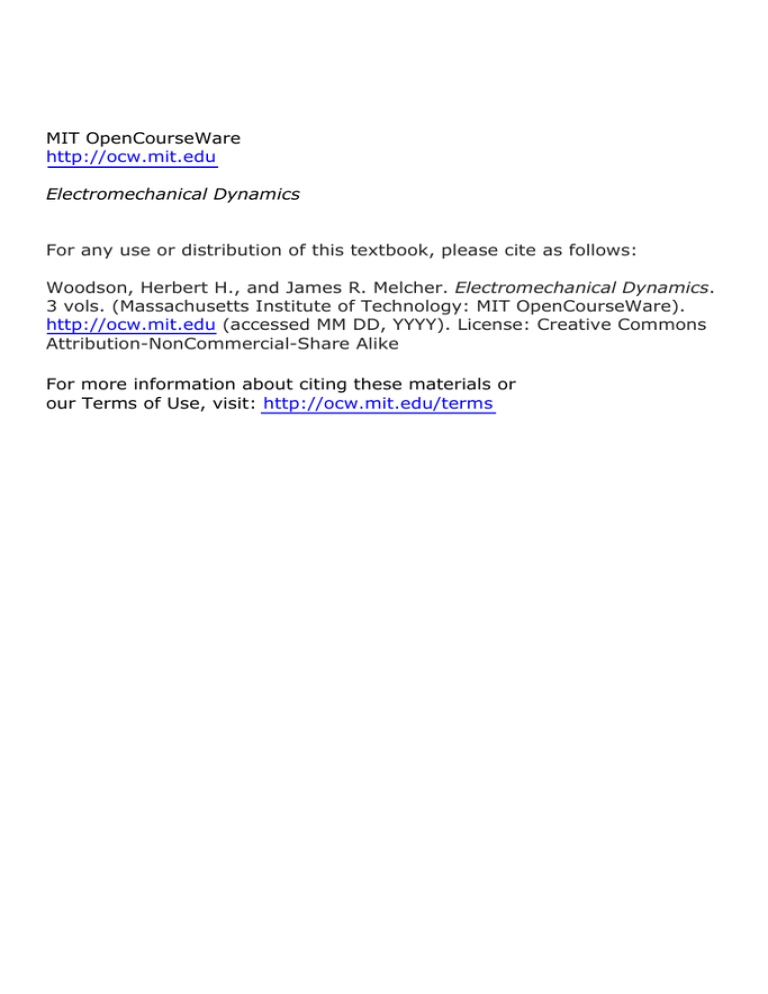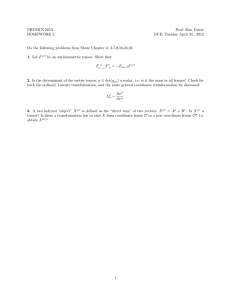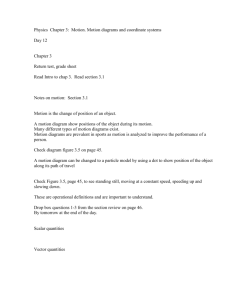MIT OpenCourseWare Electromechanical Dynamics
advertisement

MIT OpenCourseWare http://ocw.mit.edu Electromechanical Dynamics For any use or distribution of this textbook, please cite as follows: Woodson, Herbert H., and James R. Melcher. Electromechanical Dynamics. 3 vols. (Massachusetts Institute of Technology: MIT OpenCourseWare). http://ocw.mit.edu (accessed MM DD, YYYY). License: Creative Commons Attribution-NonCommercial-Share Alike For more information about citing these materials or our Terms of Use, visit: http://ocw.mit.edu/terms Appendix G SUMMARY OF PARTS I AND II AND USEFUL THEOREMS IDENTITIES AxB.C=A.Bx C, A x (B x C) = B(A. C)-- C(A- B) V( + V) = VO + vv, V. (A + B)= V .A + V- B, Vx (A + B) =V x A + V x B, V(#~Y) = # Vy + Y V#, V. (vA)= A. VV + -VV A, V.(AxB)= B.VxA--A.VxB, V VV V2= , V.V xA = 0, V xV= 0, V x (Vx A)= V(V - A) - V2 A, (V x A) x A = (A. V)A - IV(A A), V(A B) = (A- V)B + (B . V)A + A x (V x B) + B x (V x A) V x (#A)= Vo x A + VVx A, V x (A x B) = A(V B) - B(V. A) + (B V)A - (A. V)B. -I·-----·l~·l~---·U~ZI--- THEOREMS bC~ ý d= - ka.d cii G Divergence theorem Is A-nnd = .A dV Sc Stokes's theorem A dl =f(V x A).nda nda _ ___ Table 1.2 Summary of Quasi-Static Electromagnetic Equations Differential Equations Magnetic field system VX H = J Integral Equations (1.1.1) H -dl = fS J V.B = 0 B.nda = 0 B (1.1.21) V.J =0 J - n da = 0 (1.1.22) V x E aB = E' dl =-- Tt where E' Electric field system (1.1.20) n da Vx E=O (1.1.11) V D = p (1.1.12) v J,- - a V x H=J,f+ (1.1.14) aD (1.1.15) = (1.1.23) B.nda E + vXB (1.1.24) E . dl = 0 (1.1.25) SD -nda = fvp, dV J f 3 ' n da = H'.dl = - d p d V J, - n da + where J' = Jf - pfv H'=H- v x D (1.1.26) D . n da (1.1.27) Table 2.1 Summary of Terminal Variables and Terminal Relations Magnetic field system Electric field system of Terminal Variables Definition Definition of Terminal Variables Charee A, = B.nda B qk = Current i- f pidV Voltage f= Jy n'da vk E •dl ýk"I Terminal Conditions ik= dqk dt dt Ak = Ak(i1 ik = ik __ ""i- ; geometry) '"... AN; geometry) qk = qk( '...'VN; geometry) v k = CV(ql '.qN; geometry) Energy Relations for an Electromechanical Coupling Network with N Electrical and M Mechanical Terminal Pairs* Table 3.1 Magnetic Field Systems Electric Field Systems Conservation of Energy N M dWm = I ij dA, - 5j1 = - dxj (a) v dq - fij dx N (c) e dfe di + j=1 Jf dWe = j1 M N dW N f I dWe = > q1 du 1+ j=l -1 :ý fe dxj j=1 Forces of Electric Origin, j = 1 ..., M f5• = -- •Wax f = a (e) . i; ax, e (i. x 1 .... X ) (g) fe = - i= Sa wei (eW,(ql, W(v,, qN; qx Xl.... . x ,) aSx. V; . . . . . xl .... ,X3 1) Relation of Energy to Coenergy N w,+ w.'= (i) W + We = J=1 j=1 jqj Energy and Coenergy from Electrical Terminal Relations Wm i(A, ... 1 al 0 variables The mechanic T7hemechanicalva NlN j-,', and 0 ... , 0; x ..... XM ) di' (k)(O We ( . . q 1,•, can be regarded as theth force and displacement or theth torque 0 ,... ... T and angular displacement 0(n) riables fi and xi can be regarded as thejth force and displaement or trejth torque Tj and angular displacement Oj. Table 6.1 Differential Equations, Transformations, and Boundary Conditions for Quasi-static Electromagnetic Systems with Moving Media Differential Equations V x H = J, field systems (1.1.1) Transformations H' = H (6.2.14) ) (1.1.2) B' = B (6.1.37) n. (Ba - Bb = 0 V. J! = 0 (1.1.3) J,= (6.1.36) n . (Jfa - Jb) + Vy• (1.1.5) E' = E + v r x B (6.1.38) n X (E a - Eb) = vn(Ba - Bb) B = Io(H + M) (1.1.4) M' = M (6.1.39) V X E = 0 (1.1.11) E' =E (6.1.54) aB V x E= - J= field - 8 1. D = CoE + P D n (6.2.7) K, = 0 (6.2.9) (6.2.22) (E - Eb) = -0 a b) (6.2.31) D' = D (1.1.14) , = J= - pvr J, (6.1.58) (1.1.15) H' = H - v' X D (6.1.57) n X (Ha - Hb) = K + vn X [n x (D a - Db) ] (6.2.38) (1.1.13) P' = P (6.1.59) at V x H = Jf + J, (1.1.12) ; systems n x (H a - Hb) = Kf V. B = 0 V.D = pf Electric (6.1.35) Boundary Conditions = Pf (6.1.55) n (D -- D = a (6.2.33) (6.1.56) b n * (Ja _- Jb) + V~. K, = a -V(pl ) - ao at (6.2.36) Appendix G From Chapter 8; The Stress Tensor and Related Tensor Concepts In what follows we assume a right-hand cartesian coordinate system xL, x 2 , x. The component of a vector in the direction of an axis carries the subscript of that axis. When we write F, we mean the mth component of the vector F, where m can be 1, 2, or 3. When the index is repeated in a single term, it implies summation over the three values of the index aH, 8aH 8H, aH, and and a H, 8X, = H1 a 8ax a + H1 2 + 8x Hs a H V. ax This illustrates the summation convention. On the other hand, 8H,/ax, represents any one of the nine possible derivatives of components of H with respect to coordinates. We define the Kronecker delta 68,,, which has the values 1, when m = n, (8.1.7) 6,, = 0, when m 0 n. The component Tn,, of the stress tensor can be physically interpretedas the mth component of the traction (force per unit area) applied to a surface with a normal vector in the n-direction. ix1 x3 X2 Fig. 8.2.2 Rectangular volume with center at (z@,x, Xs) showing the surfaces and directions of the stresses T,,. I-*··~-·····)-·LIUI··~11111 Summary of Parts I and II The xl-component of the total force applied to the material within the volume of Fig. 8.2.2 is + = T +12 +T Ax 2 Ax3 , x3 1 2 + 3 2 (xiX2,z, x + AxAX I rT1lx - - - T12\1. , 2 xx1, -4,- T Ax 2 Ax. x 1 2 Ax3) 23\ Ax (8.2.3) Here we have evaluated the components of the stress tensor at the centers of the surfaces on which they act; for example, the stress component T11 acting on the top surface is evaluated at a point having the same x2- and x3coordinates as the center of the volume but an x1 coordinate Ax1 /2 above the center. The dimensions of the volume have already been specified as quite small. In fact, we are interested in the limit as the dimensions go to zero. Consequently, each component of the stress tensor is expanded in a Taylor series about the value at the volume center with only linear terms in each series retained to write (8.2.3) as ( =T Ax 1 + 2 T11 + -1 a 2 ax1 8x 1 A,, x2 +_x (T 3 Ax ITn aT1 1 T 2 T12 T 1 2+ + Ax L_ i-T _.aT..__ T13 +A ax, AAx ,, 3 aTh) 23 ax3 Ax 1AxA Ax,Ax, ATx 1 Ax or f = . + a-xAxAx +T (8.2.4) 3 All terms in this expression are to be evaluated at the center of the volume (x1 , x,, xa). We have thus verified our physical intuition that space-varying stress tensor components are necessary to obtain a net force. From (8.2.4) we can obtain the x,-component of the force density F at the point (x 1 , X2, x3) by writing F1 = lim Ax 1 Ayx,,Ax-OAxAxAxz, T + ax,11 ax2 + aT 13 ax, (8.2.5) The limiting process makes the expansion of (8.2.4) exact. The summation convention is used to write (8.2.5) as Appendix G F1 = T- (8.2.6) ax" A similar process for the other two components of the force and force density yields the general result that the mth component of the force density at a point is F, = (8.2.7) ax" Now suppose we wish to find the mth component of the total force f on material contained within the volume V. We can find it by performing the volume integration: d viax =jV When we define the components of a vector A as A1 = T, 1 , A 2 = T. 2, A3 T= 3, (8.1.14) we can write (8.1.13) as f, = aA dV f=V9 A) dV. (8.1.15) We now use the divergence theorem to change the volume integral to a surface integral, A.nda= integral, f= Anda, (8.1.16) where n, is the nth component of the outward-directed unit vector n normal to the surface S and the surface S encloses the volume V. Substitution from (8.1.14) back into this expression yields f, = sTmn, da. (8.1.17) where T,.n, is the mth component of the surface traction T. The traction r is a vector. The components of this vector depend on the coordinate system in which T is expressed; for example, the vector might be directed in one of the coordinate directions (xj, a, x3), in which case there would be only one nonzero component of r. In a second coordinate system (x, x', x'), this same vector might have components in all of the coordinate directions. Analyzing a vector into orthogonal components along the coordinate axes is a familiar process. The components in a cartesian coordinate system (x', x,' xD) are related to those in the cartesian coordinate system (x,, x, x,) by the three equations (8.2.10) -r= a,17 ,, where apr is the cosine of the angle between the x' -axis and the xz,-axis. _I~ ^_ _ I_ Summnunary of Parts I and II Similarly, the components of the stress tensor transform according to the equation T~, = a,,ra,,Ts. (8.2.17) This relation provides the rule for finding the components of the stress in the primed coordinates, given the components in the unprimed coordinates. It serves the same purpose in dealing with tensors that (8.2.10) serves in dealing with vectors. Equation 8.2.10 is the transformation of a vector r from an unprimed to a primed coordinate system. There is, in general, nothing to distinguish the two coordinate systems. We could just as well define a transformation from the primed to the unprimed coordinates by 7r, = b,,g, (8.2.18) where b,, is the cosine of the angle between the x,-axis and the x,-axis. But b,, from the definition following (8.2.10), is then also b,, - a,,; (8.2.19) that is, the transformation which reverses the transformation (8.2.10) is (8.2.20) 7-,= a,7,. Now we can establish an important property of the direction cosines a., by transforming the vector r to an arbitrary primed coordinate system and then transforming the components r'- back to the unprimed system in which they must be the same as those we started with. Equation 8.2.10 provides the first transformation, whereas (8.2.20) provides the second; that is, we substitute (8.2.10) into (8.2.20) to obtain 7, = a,,arT. (8.2.21) Remember that we are required to sum on both p and r; for example, consider the case in which s = 1: T1 = (alla11 + a21 a21 + a31a31)r1 + (a1la U + a2 ta2 2 + aaiae)r2 (8.2.22) 1 + (a1 1 ai 3 + asla2 3 + aa•a33)r 3 . This relation must hold in general. We have not specified either a,, or 7,-. Hence the second two bracketed quantities must vanish and the first must be unity. We can express this fact much more concisely by stating that in general a,,a, = 6,sr (8.2.23) Table 8.1 Electromagnetic Force Densities, Stress Tensors, and Surface Force Densities for Quasi-static Magnetic and Electric Field Systems* Stress Tensor T,, 8T,n Fm= n Force Density Force on media carrying free current density Jy, p constant Force on media supporting free charge density pf, e constant Force on free current plus magnetization force in which B = pH both before and after media are Jf x B T., = pHAHn - 6emndpHkHk (8.1.3) (8.1.11) pfE Tmn = eE?,En - BPnIeEiEk (8.3.3) (8.3.10) Jf x B - ½H* H Vp T,, = pHHn + V H.Hpy -- 6mn - (8.5.41) pfE - JE *E VE T.n. = E,EEn D = E both before and + 1V - after media are deformed +p Force on free charge plus polarization force in which (8.5.45) * (A) (A] -- Aa + Ab 2 2 Aa - A HaHk ap aP (8.5.38) deformed Surface Force Density* -x= (8.1.10) m F Description Ep a n 1p (8.5.46) - P E\E Tm = [Tmn]nn (8.4.2) T = Kf x lp(H> Kf = n X [H] (8.4.3) T = af(E) •, = n - [E] (8.4.8) Table 9.1 Modulus of Elasticity E and Density p for Representative Materials* Material Aluminum (pure and alloy) Brass (60-70 % Cu, 40-30 % Zn) Copper Iron, cast (2.7-3.6% C) Steel (carbon and low alloy) Stainless steel (18•% Cr, 8%Ni) Titanium (pure and alloy) Glass Methyl methacrylate Polyethylene Rubber E-units of 10u N/m2 p-units of 103 kg/m 3 v,-unitst of m/sec 0.68-0.79 1.0-1.1 1.17-1.24 0.89-1.45 1.93-2.20 1.93-2.06 1.06-1.14 0.49-0.79 0.024-0.034 1.38-3.8 x 10- 3 0.79-4.1 x i10- 2.66-2.89 8.36-8.51 8.95-8.98 6.96-7.35 7.73-7.87 7.65-7.93 4.52 2.38-3.88 1.16 0.915 0.99-1.245 5100 3500 3700 4000 5100 5100 4900 4500 1600 530 46 * See S. H. Crandall, and N. C. Dahl, An Introductionto the MechanicsofSolids, McGrawHill, New York, 1959, for a list of references for these constants and a list of these constants in English units. t Computed from average values of E and p. Table 9.2 Summary of One-Dimensional Mechanical Continua Introduced in Chapter 9 Thin Elastic Rod a26 as26 P -2 = E-Es + F, T=E- d8 6-longitudinal (x) displacement T-normal stress p-mass density E-modulus of elasticity F,--longitudinal body force density Wire or "String" m-j- =f- 2 + S -- transverse displacement m--mass/unit length f-tension (constant force) S,-transverse force/unit length Membrane / a,2e a a,2 ) -- transverse displacement am-surface mass density S-tension in y- and z-directions (constant force per unit length) T,-z-directed force per unit area G13 ""





